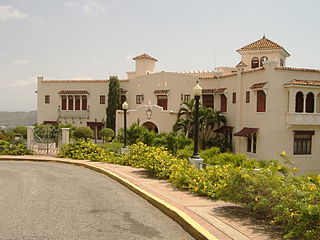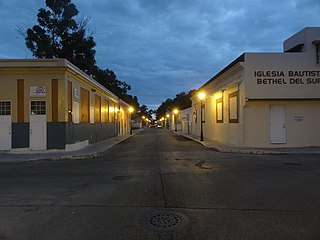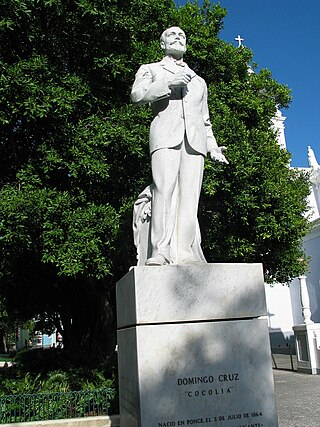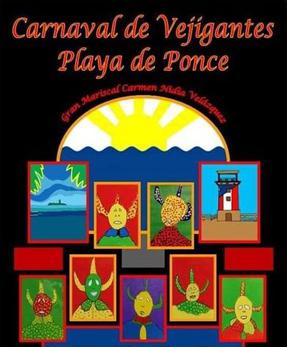
Ponce is a city and a municipality on the southern coast of Puerto Rico. The most populated city outside the San Juan metropolitan area, was founded on August 12, 1692 and is named after Juan Ponce de León y Loayza, the great-grandson of Spanish conquistador Juan Ponce de León. Ponce is often referred to as La Perla del Sur, La Ciudad Señorial, and La Ciudad de las Quenepas.

Rafael Cordero Santiago, better known as "Churumba", was the Mayor of Ponce, Puerto Rico, from 1989 to 2004. Many considered him as a synonym of Ponce, being baptized as "El León Mayor", an allusion to the city's official symbol, the lion. Mayor Cordero was a firm believer in the government decentralization process.

The Parque de Bombas is a historic former fire station in Ponce, Puerto Rico. It is one of Puerto Rico's most notable buildings, with some considering it "by far the most easily recognized landmark in the Island."

Plaza Las Delicias is the main plaza in the city of Ponce, Puerto Rico. The square is notable for its fountains and for the various monuments it contains. The historic Parque de Bombas and Ponce Cathedral buildings are located within the plaza, which actually consists of two squares: Plaza Muñoz Rivera on the north end, and Plaza Degetau on the southern end. The square is the center of the Ponce Historic Zone, and it is flanked by the historic Ponce City Hall to the south, the early 19th-century Teatro Fox Delicias to the north, the NRHP-listed Banco Crédito y Ahorro Ponceño and Banco de Ponce buildings to the east, and the Armstrong-Poventud Residence to the west. The square dates back to the early Spanish settlement in Ponce of 1670. It is the main tourist attraction of the city, receiving about a quarter of a million visitors per year.
Raúl Gándara Cartagena (1910–1989) was fire chief in Ponce, Puerto Rico, and the first and longest-serving Commonwealth of Puerto Rico fire chief. He served from 1942 to 1972.

Rafael Rivera Esbrí was Mayor of Ponce, Puerto Rico from 1915 to 1917.

Parque de la Abolición is a city park in Barrio Cuarto, Ponce, Puerto Rico. It was the first park in the Caribbean to commemorate the abolition of slavery. It was built in 1874 and renovated in 1956.

Plaza Degetau, formally Plaza Federico Degetau, is the larger of two plazas at Plaza Las Delicias, the main city square in the city of Ponce, Puerto Rico. The other plaza is named Plaza Muñoz Rivera and is located north of Plaza Degetau. The square is notable for its fountains and for the various monuments it contains. The historic Parque de Bombas and Ponce Cathedral buildings are located bordering the north side of this plaza. The square is the center of the Ponce Historic Zone, and it is flanked by the historic Ponce City Hall to the south, the cathedral and historic firehouse to the north, the NRHP-listed Banco Crédito y Ahorro Ponceño and Banco de Ponce buildings to the east, and the Armstrong-Poventud Residence to the west. The square dates back to the early Spanish settlement in Ponce of 1670. It is the main tourist attraction of the city, receiving about a quarter of a million visitors per year.

Segundo is one of the 31 barrios of the municipality of Ponce, Puerto Rico. Along with Primero, Tercero, Cuarto, Quinto, and Sexto, Segundo is one of the municipality's six core urban barrios. It was organized in 1878. Barrio Segundo has 3 subbarrios: Baldority de Castro, Clausells, and Reparada.

Domingo Cruz, a.k.a., "Cocolía", was a late 19th-century Puerto Rican musician, and director of the Ponce Firefighters' Band.

The Ponce Municipal Band, also known as Centenaria Banda Municipal de Ponce, is the band of the municipality of Ponce, Puerto Rico. The band is the oldest continuously-performing band in the Caribbean and the oldest music group in Puerto Rico. It has performed its open-air concerts for over 125 years. The current director is Juan García Germaín. It has 42 members between 25 and 83 years old. It operates within the jurisdiction of the Oficina de Desarrollo Cultural of the autonomous municipality of Ponce. Its headquarters are located at the Centro Integrado para el Fortalecimiento de las Artes Musicales, next to Teatro La Perla.

The Urban Ecological Park, also known asdthe Ponce Ecological Park, is a passive park in Ponce, Puerto Rico. The park was designed by Bonin Orozco Arquitectos and was inaugurated on 19 September 2012. The park is unique in that it was designed to create a "green lung" in the city by using ecological mindset in its entirety, from the construction materials used to the design and other areas as well. Except for one tree that got relocated within the project, the new park made use of all the existing trees and shrubs as they existed on the site prior to the development of the park.

The Monumento a los héroes de El Polvorín is a monument at Plaza Las Delicias in Ponce, Puerto Rico, dedicated to the seven fire fighters and one civilian that subdued the flames of the "El Polvorin" fire on the night of 25 January 1899.

The Monumento a los heroes de El Polvorín is a mausoleum monument in Ponce, Puerto Rico, dedicated to the seven firefighters and one civilian who subdued the flames of the "El Polvorín" fire that took place on the night of 25 January 1899 in that city.

Concha Acústica de Ponce is an open-air music and performing arts amphitheater venue in Barrio Cuarto, Ponce, Puerto Rico, owned and managed by the Ponce Municipal Government. It is located on the grounds of Parque de la Abolición. The open-air auditorium-amphitheater is used primarily for cultural events. It is open from Monday through Friday, 8:00AM to 4:30PM. Concha Acústica, as it is known today (2017), is the result of a 1956 redesign that also included the adjacent Monumento a la abolición de la esclavitud. The original design was augmented by this 1956 redesign/renovation by Francisco Porrata-Doría (1890–1971).
The following is a timeline of the history of the city of Ponce, Puerto Rico.
Las Mañanitas is an annual event held in Ponce, Puerto Rico, dedicated to Our Lady of Guadalupe. It consists of a pre-dawn popular parade, followed by a Catholic Mass, and a breakfast for attendees hosted by the municipal government. It takes place every 12 December, and is sponsored by the Roman Catholic Diocese of Ponce as well as attended by Catholic leaders from across Puerto Rico. Widely covered by the press, the annual event is attended by over 10,000 people, including religious and political leaders and the general public. Due to the coronavirus pandemic, the 2020 feast was modified in line with safety protocols: the public procession was cancelled, the day’s solemn Mass was broadcast on live television, and people were required to celebrate within their homes.

Museo Parque de Bombas is a museum located inside the historic Parque de Bombas in the Ponce Historic Zone in Ponce, Puerto Rico.

The Carnaval de Vejigantes, officially Carnaval de Vejigantes de La Playa de Ponce, is an annual celebration held at Barrio Playa in Ponce, Puerto Rico. The celebration, which commonly lasts three to five days, generally takes place in late January or early February. It started in 1991. It takes place at Parque Lucy Grillasca on PR-585 in Barrio Playa. The parade, one of the highlights of the carnival, usually takes off from Cancha Salvador Dijols on Avenida Hostos (PR-123) and ends at Parque Lucy Grillasca (PR-585). Attendance is estimated at over 15,000 people. It is attended by people from all over Puerto Rico, and some attendees are from as far as the United States. It is organized and operated by a community, civic, NGO group, not by any government or government agency.



















